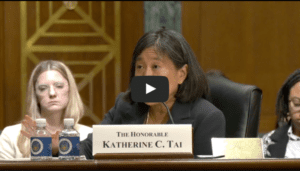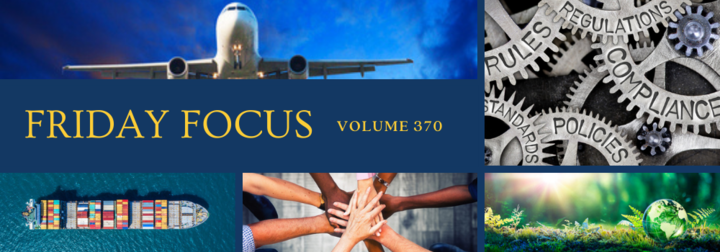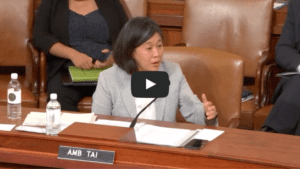Biden 2.0 or Trump 2.0? What We Might Expect on Trade Policy in a Second Term
|
On Wednesday, April 17, WITA hosted a panel to discuss what we might see on trade policy in a second Biden or Trump term as President. This event featured senior trade officials who served in key roles at USTR and the White House in the Biden and Trump Administrations. Featured Speakers: Peter Harrell, Non-Resident Fellow, Carnegie Endowment for International Peace; former Senior Director for International Economics and Competitiveness, National Security Council at the White House (2021-2022) Greta Peisch, Partner, Wiley Rein; former General Counsel, Office of the U.S. Trade Representative (2021-2024) Kelly Ann Shaw, Partner, Hogan Lovells; Lecturer in Law at Columbia Law School; former Deputy Assistant to the President for International Economics and Deputy National Economic Council Director at the White House (2018-2019) Stephen Vaughn, Partner, King & Spalding; former General Counsel, Office of the U.S. Trade Representative (2017-2019) Moderator: David Lynch, Global Economics Correspondent, The Washington Post |
|
| Ambassador Katherine Tai’s Testimonies on the President’s 2024 Trade Policy Agenda |
April 17 – Senate Finance Committee Hearing |
On April 16 and 17, U.S. Trade Representative Katherine Tai testified before the House Committee on Ways and Means and Senate Committee on Finance about President Biden’s 2024 Trade Policy Agenda.
|
Transatlantic Climate Statecraft and Global Economic Order
After World War II the United States, several European countries, and other liberal democracies promoted a vision of international economic relations that was deeply influenced by the consequences of the failed policies of the 1920s and 30s. In place of the nationalism and protectionism that characterized much of that period, the United States and its partners developed a framework for global economic order, one that stressed the primacy of multilateralism, openness, and rules. This commitment took concrete shape in institutions like the World Bank, the International Monetary Fund, and the General Agreement on Tariffs and Trade (GATT) and its successor the World Trade Organization (WTO) that have universal or near-universal membership, have aimed to advance greater international economic integration, and are grounded in international law.
This nearly 100-year cycle of destructive Realpolitik followed by idealist multilateralism is now mutating into a new global economic order whose contours are still being defined. One of the key drivers of this evolution is climate change. Within the next few years, the primacy of the multilateral trading system will be challenged by the imperative of combating this unprecedented planetary emergency. To manage that scenario, the principal stakeholders in the current system must begin charting a new path toward a future international climate order that guarantees both legitimacy and effectiveness.
Institutionalism and Experimentation
The narrative of the post-war period that puts the institutionalism of the World Bank, the IMF, and the WTO at its center is only part of the story. From the start, the rules of the GATT and then the WTO (Article XXIV) have also allowed for bilateral or regional agreements below the multilateral level if they fulfill certain criteria, and those arrangements should also be seen as contributing to the post-war economic order.
The most striking demonstration of this phenomenon is the European Union (EU), which began as the six-member Common Market in 1957 and has expanded to an economic superpower comprising twenty-seven states. Two more recent examples of this experimentalist approach are the North American Free Trade Agreement (NAFTA) signed by the United States, Canada, and Mexico in 1992 and the 2018 Comprehensive and Progressive Agreement for Trans-Pacific Partnership (CPTPP) among eleven countries. The Transatlantic Trade and Investment Partnership (TTIP) launched by the United States and the European Union in 2013 would have been the largest such free trade agreement (FTA) had it not come to a halt in 2016 owing to differences over agriculture, government procurement, and investment.
|
The Missing Dimension: Global Rules for Digital Trade
|
How many global rules exist to govern digital trade? It’s a bit of a trick question. The answer is that, aside from one specific measure, there really aren’t any. This deficiency arises because the government members of the World Trade Organization (WTO), the global trade rule body, have struggled to reach consensus on new trade rules since 1995, coinciding with the public emergence of the World Wide Web. This digital void poses an escalating challenge. In the absence of global rules to structure consistent regulations and laws for the digital economy, governments are independently addressing issues, resulting in a rising level of fragmentation that proves increasingly difficult for businesses to navigate. While the WTO governments have acknowledged the issue, their attempt to address it dates back to 1998 when they initiated a work program to discuss what was then termed electronic commerce. The group established one important rule, prohibiting WTO members from imposing customs duties or tariffs on electronic transmissions. Although this rule was initially put in place for a two-year period, it requires renewal every time trade ministers convene. The most recent ministerial conference (MC13) in Abu Dhabi at the end of February saw the moratorium on customs tariffs renewed, potentially for the last time, with an expiration date set for 2026. Despite the lack of clarity surrounding the term “electronic transmissions,” it is expansive enough to cover many digital trade activities, including cross-border delivery of software subscriptions, entertainment streaming, digital payments, and online education. The intentionally vague language adopted in 1998 aimed to allow internet-enabled transactions to continue across borders without tariff impediments. In the decades since, digital trade has burgeoned with applications that were inconceivable in the 1990s. Despite the absence of customs forms or potential tariffs for cross-border activities, if the moratorium expires, WTO members could demand customs paperwork and impose tariffs or duties on each transmission. |
|
Navigating the Trade Landscape
|
The future of global trade is being shaped by several factors, in particular the twin digital and green transitions, supply chain disruptions and the increased trade policy uncertainty driven by geopolitical tensions. Yet, in the face of these challenges, global trade has been impressively resilient. In 2022 and 2023, the total volume of traded goods increased by 1.2%, despite the outbreak of the war in Ukraine. The projections for trade growth are 2.6% in 2024 and 3.3% in 2025. Digital trade – particularly digitally delivered services – is the fastest-growing segment of international trade, with an average annual growth rate of 8.1% for almost two decades. This projected growth in trade volumes reinforces how robust the global trade system is, even in these times of significant distress and adverse pressures. However, the future of trade is certainly not without its challenges. The global economic landscape is becoming more and more complex, manifested by increasing sustainability requirements, geopolitical tensions, policy uncertainty and growing skepticism toward the ability of the multilateral trading systems to deliver. As a result, a ‘trade skeptic’ narrative has started to gain traction. This frames international trade as an obstacle to, rather than a solution for, building a more secure, inclusive and sustainable world. The challenges of the WTO The current geopolitical context is applying pressure on the World Trade Organization (WTO) to deliver on a number of urgent topics. With companies around the world relying heavily on WTO rules, the organisation needs to reform in order to address its issues, such as stalled negotiations, including the difficulty of reaching plurilateral agreements where multilateral consensus is not feasible. There is also a pressing need to repair the – currently paralyzed – dispute resolution system. In recent years, the development of the global economy has added several new concerns to trade relations within the WTO. Negotiations within the organisation have become progressively more complex, as they are increasingly influenced by domestic interests and politics. The conflict of interests between the developing and developed countries is also apparent, manifested in particular in the difficulties of WTO members in agreeing on new rules on agriculture. When allied to the fact that the WTO operates on consensus-based decision-making, it becomes more difficult to reach multilateral agreements among members that have increasingly diverse economic and political interests. |
|
|
|
|






